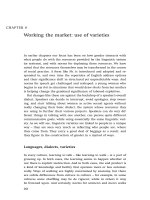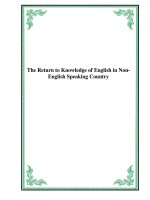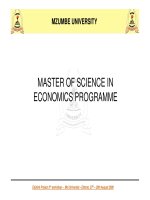Measuring Market Power Indirectly in the Insurance Market - Master of Science in Economics
Bạn đang xem bản rút gọn của tài liệu. Xem và tải ngay bản đầy đủ của tài liệu tại đây (326.3 KB, 27 trang )
Széchenyi István University
Doctoral School of Regional Science and Economics
Norbert Kovács
Master of Science in Economics
Measuring Market Power Indirectly
in the Insurance Market
PhD Thesis
Thesis Advisor: Dr. Szilveszter Farkas PhD
Győr
2011
1. Research antecedents and motivation
I developed an interest in research and academic activity at a relatively young age. I was
awarded first prize at the Scientific Student Conferences (TDK) held by Széchenyi István
University in 2001 and 2003 where I also won a second prize and a special award at the
national level in 2003. I wrote one of my TDK studies about analysing the concentration
processes of the Hungarian insurance market which was also the subject of my MSc thesis for
the insurance and finance specialization programme in 2004. This initial research has driven
me to further study the application of market power measurement methods in the insurance
market. Both my TDK activities and university studies were dominated by my interest in
economic theory and financial markets with special respect to the insurance market.
In line with my interests and field of research, I focused on economic theory also in
teaching. I taught macroeconomics as a fifth-year student and undergraduate assistant of the
General Economics Department in 2004. I joined the PhD programme in the academic year
2005/2006 while working as an economist for the National Employment Office. Between
2006 and 2008 I worked as a PhD student for the Department of International Economics and
Economic Theory of Kautz Gyula Faculty of Economics of Széchenyi István University
where I was appointed to teaching assistant in 2008. I was driven back to the University by
my love of teaching and scientific research.
I’ve been teaching economics and finance subjects including micro- and
macroeconomics, international economics and its e-learning version, international insurance,
corporate finance and public finance since February 2006 and I’ve also been involved in
teaching personal finance, financial case studies and pro-seminars. In 2008, I developed the
curriculum of subjects Market Theories and Price and Market Theory. I’ve been teaching
these subjects and developing their curriculum since the academic year 2008/2009. I’ve been
teaching Price and Market Theory also in English.
Market power measurement and analysis from the point of view of competition
authorities and companies has been a key concept in the literature of the subjects Market
Theories and Price and Market Theory. Consequently, these subjects as well as
microeconomics are closely related to my field of scientific research and the subject matter of
my thesis. It is a major research motivation for me that I can directly apply the gained
knowledge in my teaching activities.
Besides teaching, I’ve also been involved in curriculum development and research
projects managed by the Faculty, the Department of International Economics and Economic
1
Theory and its legal predecessor. Since February 2006, I’ve worked on six major research
projects of which three were closely related to the subject matter of my thesis. My
understanding of methodology and literature were greatly improved by projects titled “The
Impact of Monetary and Fiscal Policy on the Insurance Market” and “The Financial
Behaviour of Hungarian Households and Factors Shaping the Cost of Insurance” conducted in
2007. The project titled “Measuring Market Power Directly and Indirectly in the Insurance
Market” sponsored by the Competition Culture Centre of the Hungarian Competition
Authority in 2010 made a great contribution to my PhD thesis.
2
2. The objective and structure of the PhD thesis
This thesis has four key objectives. The first one is to provide a critical overview of literature
on the methodology for indirectly measuring market power in the insurance industry. The
second one is to analyse the market power of insurers present in the Hungarian insurance
market using indirect methods. The third one is to analyse the use of indirect measurement
methods in terms of the opportunities and limitations of their application and interpretation.
The fourth one is to prove that using the pure Markov chain model in indirect measurements
provides a more accurate view of market power than traditional indirect measures using the
same data.
In the first chapter of my thesis, I present the key concepts and common indirect
measures of market power and their application in the insurance market based on Hungarian
and international literature. I describe the uncertainties related to indirect measurement
concepts and methods, the limitations of their application and their implications for the
insurance market.
The second chapter is about the practical application of the indirect measurement
methodology described in the first chapter and the limitations of its application. After giving a
definition for the market and describing it in economic terms, I calculate and evaluate the
most common indirect measures of market power. I identify the factors that influence market
concentration the most. I classify the Hungarian insurance market into theoretical market
structure categories derived from oligopoly theories and I use these categories to assess
market power, and I also evaluate whether this method enables a more accurate understanding
of market power. After this, I deal with the interpretation limitations of indirect methods.
In the third chapter I present a common mathematical method used in other types of
social science research suitable to improve the efficiency of traditional indirect methods of
measuring market power. I demonstrate how the pure Markov chain model can be used to
support the indirect analysis of market power.
The fourth chapter summarizes the conclusions of the thesis.
During the empirical application of indirect market power methods and the pure
Markov chain model, I used the gross annual premium revenue and contract volume data of
insurance companies in the period between 1999 and 2009. The data are based on the
Hungarian Insurance Yearbook published by the Association of Hungarian Insurance
Companies (MABISZ). The analyses were made using SPSS 15.0. and MS Excel 2010
software.
3
3. Hypotheses
The thesis evaluates the following seven hypotheses:
H1: Based on the traditional indirect measures of market power, competition increased in the
insurance market in the period between 1999 and 2009. Competition increased in the life
insurance market to a greater extent than in the non-life insurance market.
H2: The value of HHI (Herfindahl-Hirschman-index) was influenced by endogenous market
factors to a higher extent than by exogenous factors in the period between 1999 and 2009.
H3: The classification of the insurance market into theoretical market structure categories
gives a more accurate view of market power than traditional measures.
H4: The value of HHI doesn’t clearly identify market structure which means that it has
limitations in measuring market power.
H5: The data used for calculation and the market selected for the analysis have a significant
impact on the measures of market concentration, that is, the existence of data and market
effects can be proved.
H6: The data used for calculation and the market selected for the analysis have a significant
impact on classification into market structure categories, that is, the existence of data and
market effect can also be proved for market structure categories.
H7: Applying the Markov chain model to indirectly measure market power provides a more
accurate view of market power than traditional indirect measures using the same data. This
method enables a more in-depth analysis of market structure and the prediction of transition
processes.
4
4. Methodology used to verify the hypotheses
The logical curve of this PhD thesis is based on the above described seven hypotheses that
were verified using the following methodologies.
Testing the first hypothesis I calculated the market shares of insurers and market
concentration based on insurers’ gross annual premium revenue and contract volume data.
Calculating market concentration I used three concentration measures commonly used by
international competition authorities and in Hungarian and international literature: the twofirm concentration ratio (hereinafter referred to as CR(2)), the five-firm concentration ratio
(hereinafter referred to as CR(5)), and the Herfindahl-Hirschman index (hereinafter referred
to as HHI). To estimate barriers of entry, I used the ratio of the change in the number of
market players to the total number of market players as an indirect measure. In terms of
concentration analysis methodology, I relied on the works of Bain [1951], SchmalenseeWillig [1989] and Motta [2004], as well as the available rich Hungarian and international
industrial organization literature.
The second hypothesis was tested with regression analysis. In the analysis, I divided
explanatory variables into endogenous and exogenous explanatory variables based on the idea
of Klüver [2002]. I used the combined market share of the two largest firms and the number
of firms in the market as endogenous explanatory variables and market demand as an
exogenous explanatory variable. I used two predictor variables for market demand. One
demand proxy was contract volume, representing demand in volume terms. The other proxy
was gross annual premium revenue representing current demand in value terms (Hungarian
forints). The first step in building the model was to analyse the correlation between
explanatory variables to avoid multi-collinearity. To eliminate heteroscedasticity, I took the
natural logarithm of variables, and applied linear regression to analyse the relationship
between the logarithms of such variables. I assessed the model’s goodness of fit with an F-test
and the appropriateness of explanatory variables with a t-test. The normality of distribution of
error components was tested using the Kolmogorov-Smirnov test. In terms of the used
statistical methods, I relied on the works of Hunyadi-Vita [2002], Hajdú [2003] and SajtosMitev [2007] (just like when verifying the below hypotheses).
Testing the third hypothesis I classified insurance product markets into five market
structure categories derived from oligopoly theories based on market shares calculated from
insurers’ gross annual premium revenue and contract volume data and the relationship of
these market shares. In the analysis I assumed that the shift from the most concentrated
5
category (dominant firm) to a less concentrated one and more balanced market shares
indicates a reduction in the market power of dominant firms and increased competition.
Naming and operationalising categories I relied on Hungarian and international literature
including OECD publications ”Glossary of Statistical Terms” and “Glossary Of Industrial
Organisation Economics and Competition Law”, as well as the works of Schmalensee-Willing
[1989] and Tirole [1988] and earlier empirical applications such as Dobson, W. P.–Waterson,
M.–Davies, S. W. [2003], and Juhász-Seres-Stauder [2005].
Testing the fourth hypothesis I used the previously identified concentration values and
market structure categories. Since HHI is the concentration measure most commonly used by
international competition authorities, I focused on its analysis. Findings obtained from testing
hypotheses H1 to H3 revealed that HHI, the concentration measure used in international
competition law and particularly in authorizing mergers, may have significantly different
values with the same theoretical market structure categories, and roughly identical HHI values
may indicate different market structures and competition intensities. This finding led me to
the fourth hypothesis. Testing this fourth hypothesis I used the methods of discriminant
analysis and multinomial logistic regression because of the non-metric dependent variable
(market structure category) and the metric independent variable (HHI). Normality was
assessed using the Kolmogorov-Smirnov test, while variance homogeneity was verified by the
Box’s M test.
Testing the fifth hypothesis I used the method of variance analysis because analysing
data and market effects I worked with non metrics-dependent variables (data type and market
type) and metrics-dependent variables (concentration measures). The impact of the
independent variable was verified by the F-test, while variance homogeneity was verified by
the Levene test.
Testing the sixth hypothesis I applied the method of cross table analysis because the
dependent (type of market structure) and independent (data type and market type) variables
used in the analysis are non-metric variables. The statistical significance of the correlation
between the dependent and independent variables was verified by Chi-square statistics and the
likelihood ratio.
Testing the seventh hypothesis and discussing the theoretical mathematical model of
Markov chains and their empirical application I relied mostly on the works of Adelman
[1958], Karlin-Taylor [1985], Major [2008], Stokey-Lucas [1989], and Sydsaeter-Hammond
[2006]. I studied the transitions between market positions, market structure and size
6
categories and I attempted to predict changes in market structure processes based on the
transition likelihood matrices specified using the pure Markov chain model.
7
5. Findings of the PhD thesis
H1: Based on the traditional indirect measures of market power, competition increased in the
insurance market in the period between 1999 and 2009. Competition increased in the life
insurance market to a greater extent than in the non-life insurance market.
By traditional indirect measures of market power I mean the measures most commonly
used in the methodology of competition authorities and in market power measurement
literature including the market share(s) of the largest company (or companies), HHI, CR(2)
and CR(5) whose threshold values critical for competition law are not governed by a
consensus either in literature or in competition authority practice.
In European competition law, a market share permanently in excess of 25% is
considered to be the critical value of the largest market player’s market share, that is, an
indication of dominant market power (dominant position). There are several approaches to the
threshold values of HHI as well. According to the concept most common in theoretical
literature, values permanently above 1,800 basis points are critical, values between 1,000 and
1,800 basis points indicate moderate market concentration, while values below 1,000 basis
points suggest low concentration requiring no market intervention. For CR(2) and CR(5),
critical values are 50% and 80%, respectively, above which leading companies have a
dominant market power. For the purposes of evaluation these values were used.
In life insurance product markets including risk, composite, unit linked and other life
insurance markets – other than the endowment insurance market –, the market shares of
leading market players indicating a dominant position shrank and the market shares of
follower companies increased which created a more balanced market structure in general. In
life insurance product markets, leading market players tend to have a smaller market share
than in non-life insurance markets. In the non-life insurance market and its product markets
including retail, general liability insurance, corporate and other property insurance markets,
the market shares of leading market players are around and above the threshold indicating a
dominant position. These values remained above the critical threshold over a relatively long
period between 1999 and 2009. The analysis of market shares indicates that competition is
less intense in the non-life insurance market which gives the market leader a better chance to
enforce monopolistic premiums.
Based on insurers’ gross annual premium revenue data, the life insurance market and
its product markets – except the endowment insurance market – have a declining
8
concentration which means that dominant positions got weaker and competition grew more
intense. The high concentration values of contract volume, however, failed to decrease to the
same high extent in the period under survey.
In the non-life insurance market and its product markets, HHI and closely correlated
CR(2)/CR(5) values significantly declined but permanently exceeded the value considered as
critical by competition authorities. The only exceptions are HHI and CR(2) calculated for the
corporate property insurance market and CR(5) calculated for the market of other property
insurance products. In the non-life insurance market there is a much smaller difference
between the concentration values calculated based on premium revenue and contract volume
data than in the life insurance market.
Overall, market concentration measures show a highly concentrated market which
applies especially to non-life insurance product markets. Market shares, as well as the values
of HHI, CR(2) and CR(5) measures calculated based on gross annual premium revenue and
contract volume data indicate the dominant market power of leading market players especially
in the non-life insurance market.
T1: Traditional indirect market power measures show that the dominant power of market
leaders decreased in the insurance market between 1999 and 2009 which indicates increasing
competition from a structural aspect. In life insurance product markets, dominant positions
are weaker and the values of indirect measures are closer to those accepted by competition
authorities than in non-life insurance markets. Based on the findings, I confirm hypothesis
H1.
H2: The value of HHI (Herfindahl-Hirschman-index) was influenced by endogenous market
factors to a higher extent than by exogenous factors in the period between 1999 and 2009.
I presented and evaluated market concentration using indirect measures HHI, CR(2) and
CR(5). Of these measures, HHI is the one most commonly used in market theory literature
and competition authority practice. It is vital to identify the factors having the greatest impact
on HHI. My hypothesis is that the value of HHI is influenced by endogenous structural
market processes to a higher extent than by exogenous factors. This hypothesis was verified
using two regression models. One model focused on the analysis of variables specifying the
concentration of gross annual premium revenue data, while the other focused on that of
contract volume data.
9
The predictive variable influencing the concentration of gross annual premium
revenue as measured in HHI to the highest (statistically significant) extent was the two largest
companies’ combined share of gross annual premium revenue (lnCR2_db_sz). If this value
increases, HHI increases too, and if this value decreases, HHI decreases too. Of endogenous
factors, the change in the number of companies (lnbsz) did not have a significant impact on
the HHI value of gross annual premium revenue. Of exogenous factors (representing
demand), both gross annual premium revenue (lnbdb) and contract volume (lnszerza) proved
to be significant explanatory variables. Their impact on HHI, however, was smaller than that
of the combined market share of the two largest companies.
Table 1
Factors influencing the HHI value of contract volume
Nonstandardized
coefficients
t-value
Level of
significance
(Constant)
3.995
8.785
.000
lnCR2_db_sz
0.967
12.839
0.000
-.094
-1.028
-3.250
-.074
3.357
.061
a. Dependent variable: lnHHI_db
.307
.002
.001
lnbsz
lnbdb
lnszerza
The concentration of contract volume as measured in HHI is influenced to the highest
extent by the combined market share of the two largest companies based on contract volume
(lnCR2_szá_sz). Of endogenous factors, the number of companies (lnbsz) didn’t have a
significant impact on the contract HHI. Of exogenous factors (representing market demand),
both contract volume (lnszerza) and gross annual premium revenue (lnbdb) had a significant
impact on HHI which was lower than that of the endogenous factor.
10
Table 2
Factors influencing the HHI value of contract volume
Nonstandardized
coefficients
(Constant)
1.820
lnCR2_szá_sz
1.453
lnbsz
lnbdb
lnszerza
-.076
-.046
.054
t-value
Level of
significance
7.122
28.947
.000
.000
-1.786
-3.636
5.503
.077
.000
.000
a. Dependent variable: lnHHI_szá
I studied the correlation of HHI and endogenous/exogenous factors for life and non-life
insurance markets separately, and also for the individual product markets. Based on the results
of correlation analysis, the value of HHI is influenced by the combined market share of the
two largest companies as an endogenous factor to a higher extent than by exogenous factors.
T2: Based on the results of the five-variable regression models considering all product
markets established to test the hypothesis, as well as the separate correlation analyses of the
life and non-life insurance markets, it is clear that the value of HHI was influenced by
endogenous factor CR(2) more than by exogenous factors. The impact of the number of
companies, however, was not higher than that of exogenous factors. Based on the findings, I
partly confirm hypothesis H2.
H3: The classification of the insurance market into theoretical market structure categories
gives a more accurate view of market power than traditional measures.
As a first step of testing the hypothesis, I operationalised market structure categories known
from oligopoly theories (dominant company, duopoly, asymmetric oligopoly, nonconcentrated market). After this, I classified every product market into these categories based
on market players’ market share and their relative size for every year in the period between
1999 and 2009. I evaluated the competitive situation of the individual markets based on the
change and occurrence of the individual market structure categories. Based on the findings of
the analysis, I reached the following four conclusions.
11
The first conclusion is that individual product markets can be classified into different
market structure categories based on sales value and sales volume. Every product market –
other than business and other property insurance markets – was classified into a less
competitive market structure category based on contract volume for every year of the period
under survey. Consequently, research findings confirm the earlier conclusion that the market
is more concentrated based on contract volume. In this sense, market structure analysis has
confirmed the information obtained through the use of traditional indirect measures.
The second conclusion is that market structures indicating a dominant market power
occurred more frequently in non-life insurance product markets in the period under survey.
This confirms the finding obtained when testing hypothesis H1 about the higher frequency of
market situations indicating a dominant market power in non-life insurance product markets.
In this sense, market structure analysis has confirmed the information obtained through the
use of traditional indirect measures.
The third major conclusion is that a product market can have a balanced and
competitive structure at a concentration value considered to be more critical from a
competition law perspective. On the one hand, this highlights a contradiction between the
interpretation and critical threshold values of indirect measures used in competition law and
market structure categories derived from oligopoly theories. On the other hand, the findings
also highlight that a deeper analysis is required to accurately assess the actual intensity of
market competition. In this sense, market structure analysis has complemented the
information obtained through the use of traditional indirect measures.
The fourth conclusion is that the limitations of market structure analysis should be
considered. One limitation is that compliance with the individual categories largely depends
on the pre-determined criteria. Another limitation is that similarly to traditional indirect
measures, this method fails to identify companies in the first, second and other positions by
name.
T3: The assessment of compliance with theoretical market structure categories has partly
confirmed and partly complemented (increased the accuracy of) findings obtained through the
use of traditional indirect measures. However, this method fails to provide a more accurate
view of market power in itself due to its limitations (e.g. sensitivity to category boundaries,
failure to identify market players by name), but can be useful to complement traditional
indirect measures. Based on the findings, I do not confirm hypothesis H3.
12
H4: The value of HHI doesn’t clearly identify market structure which means that it has
limitations in measuring market power.
When verifying hypothesis H3, I found that the market structure derived from oligopoly
theories can indicate lower market power even with a higher HHI value and it can indicate a
dominant market power also with a lower HHI value. This finding led me to hypothesis H4.
To evaluate this hypothesis, I had to analyse the relationship of a non-metric
dependent variable (market structure) and a metric independent variable (HHI). To analyse
the relationship between such types of data, discriminant analysis and/or more robust logistic
regression analysis should be used. In the latter case, the multinomial (polychotomous)
version of regression analysis is to be applied because the number of dependent variable
categories is more than two. During the analysis, I treated HHI values and theoretical market
structure categories identified based on gross annual premium revenue and contract volume
separately. The analysis was performed on two data sets. One data set covered the period
between 1999 and 2006 with 72 variable elements each, while the other data set covered the
period between 1999 and 2009 with 99 variable elements each.
In the analysis involving all product markets, the hypothesis was confirmed only for
data calculated from gross premium revenue in the 1999 to 2006 period. In the other cases,
that is for data calculated from contract volume for 1999 to 2006, and for data calculated from
gross premium revenue and contract volume for 1999 to 2009, the hypothesis was not
confirmed because the variance homogeneity condition was not met despite the fact the
differences in average HHI values are clearly visible (see table 38).
Confining the analysis only to life insurance product markets, I virtually got the same
result. For non-life insurance product markets, the hypothesis was confirmed only for gross
premium revenue data for the 1999 to 2006 data set. For contract volume data, however, the
hypothesis was confirmed for both data sets (see table 38).
In the course of the analysis, the variance homogeneity condition was not met on
several occasions, therefore, the hypothesis was not confirmed for the total market using
discriminant analysis. Therefore, I analysed the relationship between market structure
categories and HHI also using the more robust method of multinomial logistics regression.
Findings show that the rise in HHI value decreases the likelihood of getting from a dominant
company category to categories with a more balanced market structure for both types of data.
In the duopoly category, however, “β” coefficients, based on gross premium revenue data, are
negative but not significant, the intercepts are not significant, and the Nagelkerke-R2 values
13
range between 30% and 60% indicating moderate explained variance. This means that an
increase in the value of HHI does not necessarily lead to transition to a more concentrated
market structure category.
T4: The analysis of the relationship between HHI and market structure categories revealed
that HHI fails to clearly identify market structure. The market structure can include dominant
positions with a lower HHI, and it can be more balanced with a higher HHI value. That is,
HHI has limitations in measuring market power, therefore, the precise conditions of its
application should be further studied. Based on the findings, I confirm hypothesis H4.
H5: The data used for calculation and the market selected for the analysis have a significant
impact on the measures of market concentration, that is, the existence of data and market
effect can be proved.
Hypothesis H5 is based on the findings of the concentration analysis prepared to verify H1,
namely, that calculations based on gross premium revenue and contract volume data – that is,
two sales-related data – can provide highly different concentration values for the same
product market. The same analysis revealed that non-life insurance product markets have a
higher level of concentration. The impact of the data used for the analysis is demonstrated by
the fact that there is only a moderate relationship between HHI calculated based on gross
annual premium revenue data and HHI calculated based on contract volume data for all
product markets and for life and non-life insurance product markets. The same applies to
CR(2) – which changes together with HHI. For CR(5), this relationship is stronger but the
values calculated based on the two basic data are not fully correlated. There is a significant
difference also in the concentration values calculated for life and non-life insurance markets.
The existence of data and market effects was verified using variance analysis because
of non-metric independent and metric dependent variables. The analysis was performed based
on two data sets also for H5. One data set covered the period between 1999 and 2006 with 72
variable elements each, while the other data set covered the period between 1999 and 2009
with 99 variable elements each.
Based on the findings of variance analysis, there is a verifiable data effect in the case
of all three concentration measures used for measuring market power including CR(2), CR(5)
and HHI. For CR(2), the data effect did not prove to be significant for the 1999 to 2009 data
set, but it did prove to be significant for the smaller 1999 to 2006 data set. For the other two
measures, the presence of the data effect was verified for both data sets.
14
The market effect was confirmed for HHI and CR(5) using a statistical method for the
1999 to 2009 data set, while it was confirmed for CR(2) on both data sets. Based on the
findings of variance analysis on the 1999 to 2006 data set for HHI and CR(5), the market
effect is not significant despite the fact that the average concentration values of non-life
insurance product markets are clearly higher than those of life insurance product markets. In
light of the findings, life and non-life insurance markets have different levels of concentration
with the concentration level of the non-life insurance market being higher.
T5: Data and market effects are present in market concentration measures. The analysis of
the market effect revealed that in the Hungarian insurance market, gross annual premium
revenue has a lower level of concentration than contract volume does. This also means that
even those market players can realise a substantial gross premium revenue that have a lower
contract volume. This is an indirect indication of increased competition for customers. In
terms of methodology, this finding shows that calculating and interpreting market
concentration based on both gross annual premium revenue and existing contract volume
provides more information on market power and competition than calculating concentration
based on gross premium revenue or contract volume alone. The existence of the market effect
also serves as a proof for the higher concentration of the non-life insurance market, and the
higher market power of leading players in the non-life insurance market. From a
methodology perspective, it is also important that the market selected for the analysis has a
significant impact on analysis results which confirms the vital importance of identifying the
relevant product and geographical market and collecting the appropriate data. Based on the
findings, I confirm hypothesis H4.
H6: The data used for calculation and the market selected for the analysis have a significant
impact on classification into market structure categories, that is, the existence of data and
market effects can also be proved for market structure categories.
Findings obtained from testing H3 confirm that there is a difference in the most frequent
market structure categories depending on the data and market selected for the analysis.
15
Table 3
The most frequent types of market structure
1999-2009
Product market
Risk
Endowment
Composite
Unit linked
Other life
Retail
General liability
Corporate
Other property
Gross
premium
revenue
DUO
DC
AO
AO
AO
AO
DUO
DUO
DC
Contract
volume
AO
AO
DC
AO
DC
AO
AO
AO
DC
1999-2006
Gross
premium
revenue
DUO
DUO
AO
AO
DC
AO
DUO
DUO
DC
Contract
volume
AO
AO
DC
DUO
DC
DC
AO
DC
DC
DC: dominant company, DUO: duopoly, AO: asymmetric oligopoly
These results lead to the question whether the data and market used for the analyses
have a significant impact on classification into market structure category.
The data effect can be identified using cross-table analysis because the dependent
variable used in the analysis (type of market structure) as well as the independent variable
(data used for the analysis) are both non-metric variables.
The Chi-square and likelihood ratio results of the cross-table analysis show that the
selection of the basic data has a significant impact on classification into theoretical market
structure categories based on both data sets (1999 to 2009 and 1999 to 2006).
The market effect can also be identified using cross table analysis. The Chi-square and
likelihood ratio results of the cross-table analysis show a significant market effect only based
on the 1999 to 2009 data set. This means that the difference in the frequency of different
theoretical market structures clearly present in the life and non-life insurance markets in the
1999 to 2006 period cannot be considered as significant.
T6: The presence of data and market effects can be verified also for theoretical market
structure categories. The testing of the data effect revealed that the structure of individual
product markets is more concentrated and has more dominant attributes based on contract
volume than based on gross annual premium revenue. On the one hand, this means that
smaller companies can acquire a major share from annual sales which is an indirect
indication of increased competition and, therefore, is an important piece of information for
the market as a whole. On the other hand, the presence of the data effect confirms that the
16
combined use of gross annual premium revenue and existing contract volume enhances the
accuracy of conclusions when measuring market power using indirect measures. The market
effect analysis also confirmed that dominant market structures are more frequent in non-life
product markets. The presence of the market effect shows that using aggregate data covering
the entire market in the analysis may conceal results important for the appropriate evaluation
of market power. Based on the findings, I confirm hypothesis H6.
H7: Applying the Markov chain model in indirectly measuring market power provides a more
accurate view of market power than traditional indirect measures using the same data. This
method enables a more in-depth analysis of market structure and prediction of transition
processes.
The analysis of the indirect measures of market power identified a contradiction between the
individual indirect methods, and revealed that the information obtained through indirect
measures is distorted by data and market effects. These methods fail to identify the individual
market players by name which may conceal information vital for the evaluation of market
power. The use of the pure Markov chain model is justified by its capability of providing the
analyst with substantial extra information on market structure and market power using the
same data as traditional indirect analysis (that is, gross annual premium revenue and contract
volume data). Using this method, the likelihood of transitions between the market positions of
leading players (categories established by company size) and theoretical market structure
categories can be assessed. This model enables the dynamic analysis of market structure and
the prediction of expected structural processes which may enhance the role of prevention at
competition authorities.
The Markov chain model, however, has its limitations. The first one is the stationary
condition that transition likelihood values do not change which supports prediction but
reduces accuracy. Another limitation is that a specific number of market players is used to
establish transition matrices. The next limitation observed during the empirical testing of the
model is that the transition likelihood matrix is sensitive to category boundaries. The Markov
chain model tends to overestimate categories with a higher weight (more players) and
underestimate those with a smaller weight. Due to these limitations, the results obtained using
traditional market power measures should also be considered.
T7: Based on the analyses of the Hungarian insurance market, the Markov chain model
provides a more accurate view of market power than traditional indirect measures using the
17
same data. Using the Markov chain model for indirect measurement enables a more in-depth
analysis of the market positions of the largest companies, and that of transitions between
market structure and size categories. As a result, it provides a more accurate understanding
of market structure processes which is essential for analysing market power. The pure
Markov chain model can be used also to predict structural processes in the market.
Predictions are more accurate if they are based on gross premium revenue. Accuracy
substantially deteriorates when increasing the time horizon of predictions. The improvement
of accuracy requires further research. Based on the finding, I confirm hypothesis H7.
18
6. New scientific findings of the PhD thesis
The new findings of the PhD thesis are summarised as follows:
1.
The thesis includes the first Hungarian language summary of market power
measurement literature with a focus on the insurance market.
2.
Calculation and analysis of indirect market power measures – market shares and the
three measures of market concentration: CR(2), CR(5), HHI – for the Hungarian insurance
market in the period between 1999 and 2009 and the evaluation of market power based on
these indirect measures. I confirmed that traditional indirect market power measures show
increased competition in the insurance market. Competition increased to a greater extent in
the life insurance market and its product markets than in non-life insurance markets.
3.
Identifying factors determining HHI values using the regression model. I proved that
CR(2) is the endogenous market factor influencing HHI values the most.
4.
Classifying the Hungarian insurance market into market structure categories derived
from oligopoly theories in the period between 1999 and 2009, and analysing market power
based on these categories. Comparing this method to traditional indirect measures.
5.
I proved that the indirect market power measure most commonly used in literature and
merger authorizations, that is, HHI-based market concentration fails to give an accurate view
of market power and it doesn’t unambiguously identify market structure. Market structure can
be balanced or include dominant positions with both a low and a high HHI value.
6.
Identifying new limitations and opportunities for the use of concentration analysis in
the insurance market through evaluating and interpreting the impact of the selected data and
market on the value of concentration measures. I verified that the values of market
concentration measures significantly depend on the basic data and the market selected for the
analysis, that is, both the data effect and the market effect apply. I also presented the
implications of the verified existence of these effects on market power and competition
intensity values, as well as on the theory and practice of measurement methodology.
7.
Analysing and interpreting the effect of the data and market selected for the analysis
on market structure categories. I presented the implications of the verified existence of these
effects on market power and competition intensity values, as well as on the theory and
practice of measurement methodology.
8.
Evaluating the applicability of the Markov chain model in market structure analyses. I
demonstrated that the pure Markov chain model provides a more accurate view of market
power than traditional indirect measures even if data limitations apply, because the model
19
enables the analysis of internal structural dynamics and supports the prediction of market
structure transitions.
20
7. Future research directions
In the future, I wish to conduct research in the following areas:
1.
Rethinking and clarifying the fundamental concepts and systems of
market power measurement methods
2.
Further improving the indirect analysis of market power using
stochastic models; extending research in the Hungarian insurance market to cover the
insurance markets of other countries in Central and Eastern Europe
3.
Understanding the models and analytical tools of behavioural
economics and evaluate their applicability by competition authorities
4.
Improving the business application of competition analysis methods of
market theory
21
8. Publications and presentations on the subject
Publications
1. Kovács Norbert [2010]: Piaci részesedések eloszlásának előrejelzése Markov-modellel a
biztosítási piacon. In: Válság közben, fellendülés előtt, Kautz Gyula Emlékkonferencia
elektronikus formában megjelenő kötete, (ISBN 978-963-7175-57-2)
2. Kovács Norbert [2009]: Gépjármű-biztosítási tendenciák 1995-2006. Biztosítási Szemle,
LV. évfolyam, 1. szám, 27-37.o.
3. Kovács Gábor – Kovács Norbert – Losoncz Miklós – Solt Katalin – Takács Dávid [2008]:
A költségvetési és monetáris politika hatása az életbiztosítási piacra. Külgazdaság, LII.
évf., 60-74.o.
4. Kovács Norbert [2007]: A magyar biztosítási piac szerkezetének átalakulása, in:
„Versenyképesség – Fejlődés – Reform”, CD-kiadvány, Sopron, (ISBN: 978-963-066387-8)
5. Kovács Norbert [2007]: The Transition Of The Hungarian Insurance Market Structure In
Market Economy, in: "The problems of Ukrainian financial system development in the
conditions of eurointegration", Lviv State University, 218-224.o.
6. Kovács Norbert [2007]: A magyar biztosítási piac átalakulása 1986 után. In:„20. századi
magyar gazdaság és társadalom”, Konferenciakötet, Széchenyi István Egyetem, Kautz
Gyula Gazdaságtudományi Kar, Győr, 483-491.o. (ISBN 978-963-7175-38-1)
7. Kovács Norbert [2007]: A magyar biztosítási piac szerkezetének átalakulása. In: Európai
Integráció – Elvek és döntések I., II., Pannon Gazdaságtudományi Konferencia
Tanulmánykötet I., 237-245.o. (ISBN 978-963-9696-29-7)
8. Kovács Norbert [2007]: How to Analyze the Structure of the Insurance Market? ? in:
European Scientific Conference of PhD students, published on CD, Mendel University
Brno (ISBN 978-80-903966-6-1)
9. Kovács Norbert [2006]: Meghatározó-e a múlt a magyar biztosítási piac szerkezetében?
in: Apáczai Napok Tanulmánykötet I-II., NYME, Győr, 114-121.o. (ISBN 978-963-728718-3)
10. Kovács Norbert [2006]: Versenyző biztosítási piac Magyarországon? Biztosítási Szemle,
LII. évfolyam, 3. szám, 31-42.o.
22
11. Kovács Norbert [2006]: Piaci szerkezet és teljesítmény. Mérési módszerek és lehetőségek.
In: Tavaszi Szél 2006, Konferencia Kiadvány, 423-426.o. (ISBN 963 229 773 3)
12. Kovács Norbert [2006]: Okozhat-e az aszimmetrikus információ instabilitást a biztosítási
piacon? In: Pénzügyi Stabilitás mikro, mezo- és makro szinten, Széchenyi István Egyetem,
Kautz Gyula Gazdaságtudományi Intézet, Tudományos Füzetek, Universitas Kht., Győr,
191-213.o. (ISSN 1589-2697)
13. Kovács Norbert [2005]: Biztosításverseny Magyarországon? In: Széchenyi István
Egyetem, Jog- és Gazdaságtudományi Kara, Multidiszciplináris Társadalomtudományi
Doktori Iskola, Évkönyv, 191-201.o. (ISSN 1787-9698)
Presentations
1. Kovács Norbert [2011]: The Application of Markov Chain Models in Indirect
Measurement of Market Power. Workshop on Stochastic Methods in Financial Markets
Ljubljana
2. Kovács Norbert [2011]: Biztosítástechnikai tartalékok válság- és versenykörnyezetben,
Széchenyi István Egyetem, Kautz Gyula Gazdaságtudományi Kara „Magyarország
társadalmi-gazdasági helyzete a 21. század első évtizedeiben” c. konferencia
3. Kovács Norbert [2010]: Piaci részesedések eloszlásának előrejelzése Markov-modellel a
biztosítási piacon. Széchenyi István Egyetem, Kautz Gyula Gazdaságtudományi Kara
Válság közben, fellendülés előtt, Kautz Gyula Emlékkonferencia
4. Kovács Norbert [2007]: A magyar biztosítási piac szerkezetének átalakulása,
„Versenyképesség – Fejlődés – Reform” Konferencia, Sopron
5. Kovács Norbert [2007]: The Transition Of The Hungarian Insurance Market Structure In
Market Economy. "The problems of Ukrainian financial system development in the
conditions of eurointegration", Conference of Lviv State University, Lviv
6. Kovács Norbert [2007]: A magyar biztosítási piac átalakulása 1986 után, „20. századi
magyar gazdaság és társadalom”, c. konferencia, Széchenyi István Egyetem, Kautz Gyula
Gazdaságtudományi Kar, Győr
7. Kovács Norbert [2007]: A magyar biztosítási piac szerkezetének átalakulása. II. Pannon
Gazdaságtudományi Konferencia, Pannon Egyetem, Gazdaságtudományi Kar, Veszprém
8. Kovács Norbert [2007]: How to Analyze the Structure of the Insurance Market? European
Scientific Conference of PhD students, Mendel University Brno
23
9. Kovács Norbert [2006]: Meghatározó-e a múlt a magyar biztosítási piac szerkezetében?
Apáczai Napok Konferencia, Nyugat-Magyarországi Egyetem, Apáczai-Csere János Kar,
Győr
10. Kovács Norbert [2006]: Piaci szerkezet és teljesítmény. Mérési módszerek és lehetőségek.
Tavaszi Szél Konferencia, Kaposvári Egyetem, Kaposvár
11. Kovács Norbert [2006]: Okozhat-e az aszimmetrikus információ instabilitást a biztosítási
piacon? Pénzügyi Stabilitás mikro, mezo- és makro szinten konferencia, Széchenyi István
Egyetem, Kautz Gyula Gazdaságtudományi Intézet, Győr
Other publications
1. Dusek Tamás – Kovács Norbert [2011]: A Széchenyi István Egyetem helyi termelési és
jövedelmi hatásai. In: Felsőoktatási Műhely, 3. szám (megjelenés alatt)
2. Koppány Krisztián – Kovács Norbert [2011]: Fundamentális elemzés. Széchenyi István
Egyetem, (megjelenés alatt)
3. Farkas Szilveszter – Kovács Norbert [2010]: Egyetemi és főiskolai hallgatók vállalkozói
aktivitása Magyarországon. In: 8th International Conference on Management, Enterprise
and Benchmarking, June 4-5, 2010 Budapest, Proceedings, 277-287. p. (ISBN 978-6155018-01-5)
4. Dusek Tamás – Kovács Norbert [2009]: A Széchenyi István Egyetem hatása a helyi
munkaerőpiacra. In: A Virtuális Intézet Közép-Európa Kutatására (VIKEK) Évkönyve
2009. I. évfolyam, 1. szám., Kaposvár, 69-74.o.
5. Losoncz Miklós – Kovács Norbert [2008]: The relationship between crude oil and natural
gas prices, in: World Commodity Prices 2008-mid 2010, Association of European
Conjuncture Institutes, Louvain-la-Neuve, Belgium
6. Kovács
Norbert
[2006]:
Nemzetközi
Felnőttképzési Központ, Győr
24
gazdaságtan,
Széchenyi
István
Egyetem









